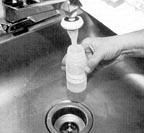
Even if offering testing is not something you'd consider, clients still will benefit from having this information on hand - and will appreciate receiving it from you before any water problems arise. If you're already supplying clients with testing parameters, what's presented here also can serve as a gentle reminder as to when wells should be tested.
Routine Tests
The testing frequencies presented here are general guidelines. Tests should be done more often if a problem with the quality of drinking water is suspected.Once each year, well owners should test for coliform bacteria, nitrate, pH and total dissolved solids (TDS), and it's best to test for these contaminants following a rainy period. These tests should also be conducted after repairing or replacing an old well or pipes, and after installing a new well or pump.
Every three years, tests should be done for sulfate, chloride, iron, manganese, lead, hardness and corrosion index.
If a new baby is expected in a household with a well, it is a good idea to test for nitrate in the early months of a pregnancy, before bringing an infant home and again during the first six months of the baby's life to avoid methemoglobinemia, or "blue baby syndrome."
Situations in the Home
Following are household situations that should prompt water testing:If family members or houseguests have recurrent incidents of gastrointestinal illness, tests for coliform bacteria, nitrate and sulfate should be conducted.
If water stains plumbing fixtures and laundry, tests should be run for iron, manganese and copper.
If water has an objectionable taste or smell, tests for hydrogen sulfide, pH, corrosion index, copper, lead, iron, zinc, sodium, chloride and TDS should be done.
If water appears cloudy, frothy or colored, tests for color, turbidity and detergents are needed.
If water supply equipment wears rapidly, tests should be conducted for pH, corrosion index, sand and silt.
If water leaves scaly residue and soap scum, and the cleaning action of soaps and detergents is decreased, testing for hardness is needed.
If a water softener is needed to treat hard water, tests for iron and manganese, which decrease the efficiency of cation-exchange softeners, should be done before the purchase and installation of this type water treatment system.
Special Situations
As you know, the environment around the well can sometimes affect the quality of well water. If someone with a well becomes ill, or the taste, odor or color of the water changes, the water supply may be contaminated. Following are some situations that call for additional testing.If the well is in an area of intensive agricultural use, tests for pesticides commonly used in the area, coliform bacteria, nitrate, pH and TDS should be conducted.
If the well is in an area near a coal or other mining operation, tests for iron, manganese, aluminum, pH and corrosion index should be run.
If the well is near a gas-drilling operation, tests should be conducted for chloride, sodium, barium and strontium.
If the water smells like gasoline or fuel oil, and the well is located near an operational or abandoned gas station or buried fuel storage tanks, testing for fuel components or volatile organic compounds (VOCs) is necessary.
If the well is near a dump, junkyard, landfill, factory or dry-cleaning operation, tests for VOCs (such as gasoline components and cleaning solvents) pH, TDS, chloride, sulfate and metals should be conducted.
If the well is near seawater, a road-salt storage site or a heavily salted roadway, and the water tastes salty or signs of corrosion appear on pipes, tests for chloride, TDS and sodium are needed.
ND

Report Abusive Comment